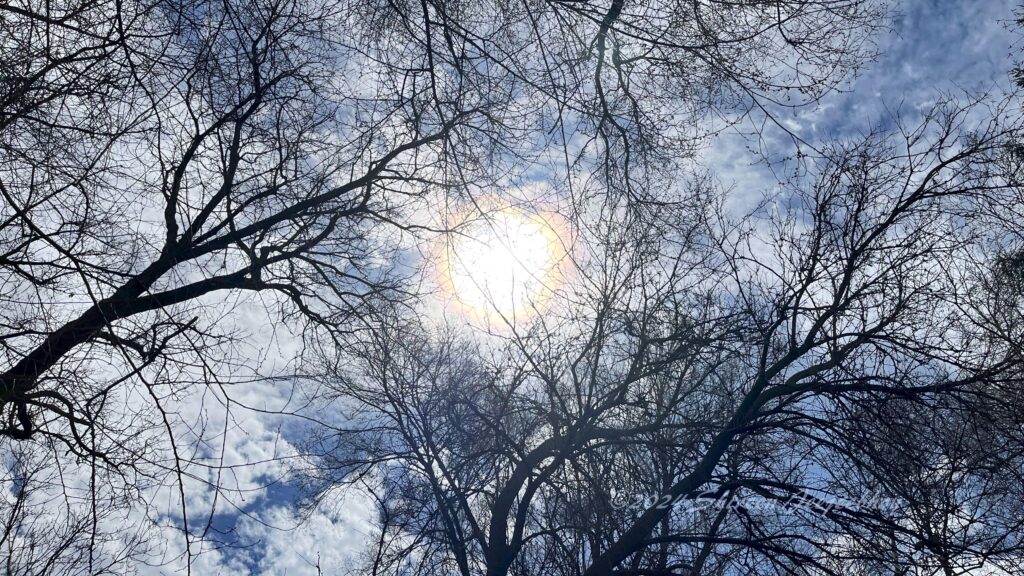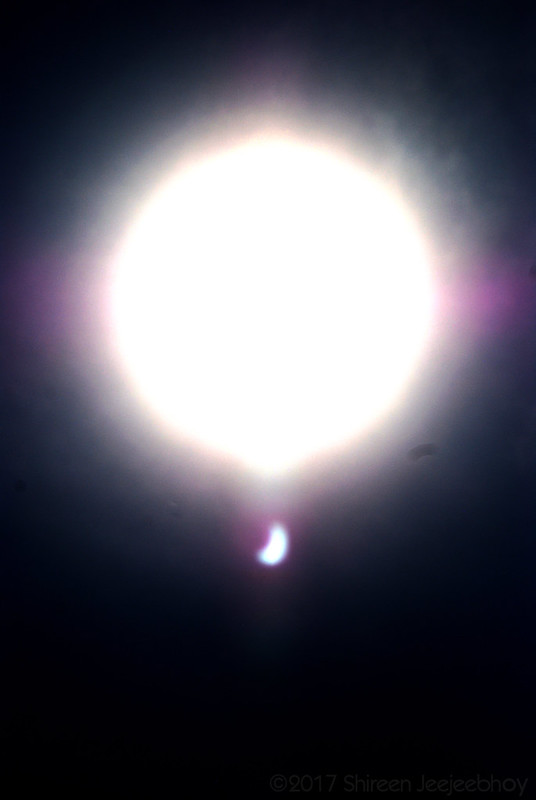Solar eclipse 2024 makes four. Yup, I’ve now witnessed four solar eclipses! My first one remains my most memorable. I was very young. Three years old, maybe?? Everyone traipsed up to the roof of the apartment building to witness the spectacle. My parents told me not to look up at the sun until they said so. Dad probably explained why, as explanations were usually the best way to get me to obey plus it was science, and I was fascinated. I remember the sky blackened like night. The ring of red. I wasn’t afraid, more curious, wanting to see more. When you’re a child, everything is new, and in that sense, a solar eclipse would be no different than tasting a mango for the first time.
It remains my most memorable solar eclipse.
The second one in my memory happened in 2015. I was chatting with my cousin in Gloucestershire when I became puzzled at how dark it was becoming outside. I mean, after living under Canada’s bright sun, England’s daylight is like wearing a perpetual pair of light sunglasses; still, the increasing darkness seemed extreme. My cousin told me there was an eclipse on in the UK. I grabbed my camera, rushed outside, and aimed it blindly towards the sun. I knew enough not to look at the solar eclipse directly despite the clouds doing their best to obscure the show. They parted at the best moment about 9:30 AM. I think it was 90% eclipsed.
For my third eclipse, in 2017, I traipsed to a wide open park with a view of the downtown to join Torontonians witnessing the spectacle. I didn’t have solar eclipse glasses, so once again, I aimed my camera blindly and watched the eclipse through photos on the screen.
We had good skies.
Too bad, we didn’t have the same for the total solar eclipse this year, for Toronto was so close to the path of totality that it would’ve been a way better show than in 2017. I used my Nikon D80 in 2015 and 2017, but it’s rather deader than a doornail now, so I only had my iPhone 13 Mini for 2024’s solar eclipse. I totally forgot to put the solar eclipse glasses over the lens for the some of the shots like I’d intended. Sheesh.
Earlier this year, I felt a little detached from all the hype about North America’s first total solar eclipse in decades. After all, I didn’t have a proper working camera, and I didn’t want to spend money on eclipse glasses. Also, the cloud forecast I, and many many others across the continent, watched for was not good. But then with 2 weeks to go, I decided to order solar eclipse glasses on sale from an approved online source and received them with days to spare.
I prayed. I hoped. The clouds will vanish! I should’ve blown on them like a Tweep on Bluesky did when they parted where she lives in time for totality! (What do we call friends and connections on Bluesky anyway?)

The eclipse began with clouds so thick, I couldn’t see the sun with my solar eclipse glasses nor figure out where it was with my bare eyes. But I noticed a line of blue sky near the horizon. The line began to creep up towards the sun’s location. Was there hope? Would I see the sun? I put on my eclipse glasses and saw!
A tiny orange disk with a bite out of it!!
It’s so strange, really. It was tiny, just a bitten-off-circle of orange in a sea of black. Yet seeing the moon’s bite stirred me. I pointed my iPhone in the general direction and took three photos with my arms outstretched, each photo at a different angle.
At first, I only caught the changing colours in the clouds.
But then I caught the sun itself with the moon’s ravenous bite.

I’d lined up a chair with the sun to throw a shadow directly behind it so that I could photograph its lines. Apparently, shadows sharpen as the eclipse progresses.
And then the clouds gathered together, huffing that mere Torontonians are not allowed to see peak 99.5% eclipse. Imprecations. Bleeped words. Long sigh.
I switched to noticing colours. Daffodils and bluebells stood out; the cast of the air was not only darker but seemed…orangey-yellow-red? I noticed the way the sky darkened and the birds went from a flurry of singing at the start of the eclipse to only a few sporadically chirping near peak eclipse. I noticed the air getting colder. Suddenly, as the world turned dark below the trees — the clouds keeping the sky lighter by diffusing the sun’s rays across their whiteness — the temperature dropped precipitously. I went from being OK in a flannel shirt to wishing I had a wool coat on.
A minute or two later, the sky brightened quicker than it had darkened, and it warmed up slowly.
I wandered my neighbourhood under the obscuring clouds after peak eclipse, overhearing neighbours telling each other that the show was over. Say what? The clouds can still part and show the partial eclipse! Did people think the moon skipped out of the sun’s path immediately after peak eclipse? Weird.
Anyway, I noticed a splotch of blue sky. And there it was again the eclipse!
For the next couple of days, disappointment ate at me at the clouds obscuring the best show I would’ve seen since I was a child. Seeing the photos from 2015 heightened my disappointment because that one was very close to total at 90%, so 2024’s 99.5% would’ve been tremendous. I experienced disappointment so strong, it snuffed the excitement at my first sight of the bitten sun through the solar eclipse glasses and my excitement at seeing the partial reappear. But I worked on my best photos right away and uploaded them to Flickr. I reminded myself that some don’t even see one, and I’ve seen four! And this time I got to see it directly again.
Solar Generation
On Bluesky, climate change experts noted that the eclipse would lead to a precipitous drop on solar generation. Ontario’s Independent Electricity System Operator had first measured that in 2017. I hadn’t thought of that! I checked my solar generation app.

Whoa! My panels generated a bare 14.5 W (yes, Watts!) at peak eclipse! At 3:19PM, generation dropped from 4.2 kW at 2:15, 15 minutes after the eclipse began. I double checked, but aside from snow blankets, my panels usually generate more than 14 W during rain and snow.






